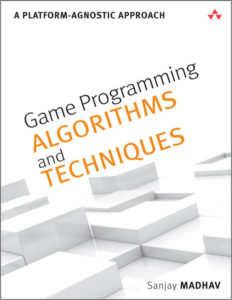Review: Game Programming Algorithms and Techniques: A Platform-Agnostic Approach by Sanjay Madhav

Game Programming Algorithms and Techniques is one of those books that tries to be as general as possible, and I believe the author was successful in that. Too many books target one specific piece of software or even one particular version of a framework and end up becoming dated rather quick. However, the core ideas in game development have not fundamentally changed in a while. Sure graphics get better, and there are more complexities to working with modern hardware, but the programming algorithms themselves are still very much the same.
Sanjay Madhav starts the book with an overview of some classic games, how a game loop works, handling timing in games, and the idea of game objects. Next he discusses 2D games, sprites, scrolling, and tile maps. There is a quick chapter on linear algebra. Then the author continues with a treatment of 3D graphics, including coordinate spaces, lighting and shading, visibility and transformation. Handling input is covered as is sound. There is a chapter on physics, which I much appreciated, and then some quick coverage of cameras, artificial intelligence, user interface, scripting, and networking. Finally, the book closes with two example projects.
The author does a great job of explaining complex concepts in easy to understand language, especially in the math and physics chapters, which could be confusing otherwise. One of the pieces that I gained a lot from was the explanation of mouse picking 3D objects, which was described beautifully and made a lot of sense. The chapter on scripting languages was also helpful and relevant.
Overall I enjoyed the book, and think it would be helpful to beginning programmers, or experienced coders in other fields looking to get into game development. I feel that for intermediate to advanced game programmers, much of this book will be a review. Not to knock the book for that, though, I think it’s a great book if you understand the audience it’s aiming for. I mean, there were even a few bits of information that were new to me, however much of the book was about stuff I’ve seen before.
That said, I do like to read texts of various levels, and even beginner books can help you look at familiar problems in new ways. So I think it’s very much worth reading, especially if you are just starting out in game development.